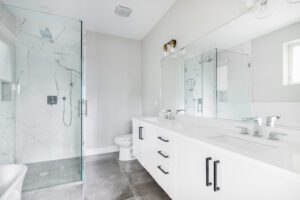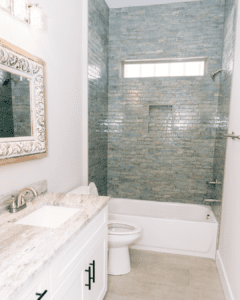Elevate Your Bathroom with Stunning Accent Wall Ideas
Introduction
In this blog post we will cover tips for designing a bathroom accent wall. Adding an accent wall to a bathroom can be a game-changer in transforming the entire space. This design choice goes beyond the ordinary and injects personality and flair into an otherwise functional room. An accent wall’s materials, lighting, and design elements can create a captivating and mood-altering effect.
Materials play a pivotal role in the transformation process. A popular option is paint, which allows for endless color choices. A vibrant hue can infuse energy and vibrancy, while a muted tone can evoke calmness and relaxation. Alternatively, tiles can bring texture and visual interest to the space. The wide variety of materials can significantly impact the overall atmosphere. Lastly, wallpaper can introduce intricate patterns or even realistic textures that are difficult to achieve with paint and easier to install than tile.
Painting for Personality
Painting an accent wall in a bathroom is a fantastic way to infuse character and style into the space. The choice of color can significantly impact the room’s mood, especially for bathrooms, where light and dark colors can create different moods. Light colors like soft pastels and pale neutrals can make the bathroom feel more open and airy. These hues reflect light, giving the illusion of a larger space, and evoke a sense of tranquility and cleanliness. Lighter colors work well in bathrooms without natural light, creating a welcoming and refreshing atmosphere.
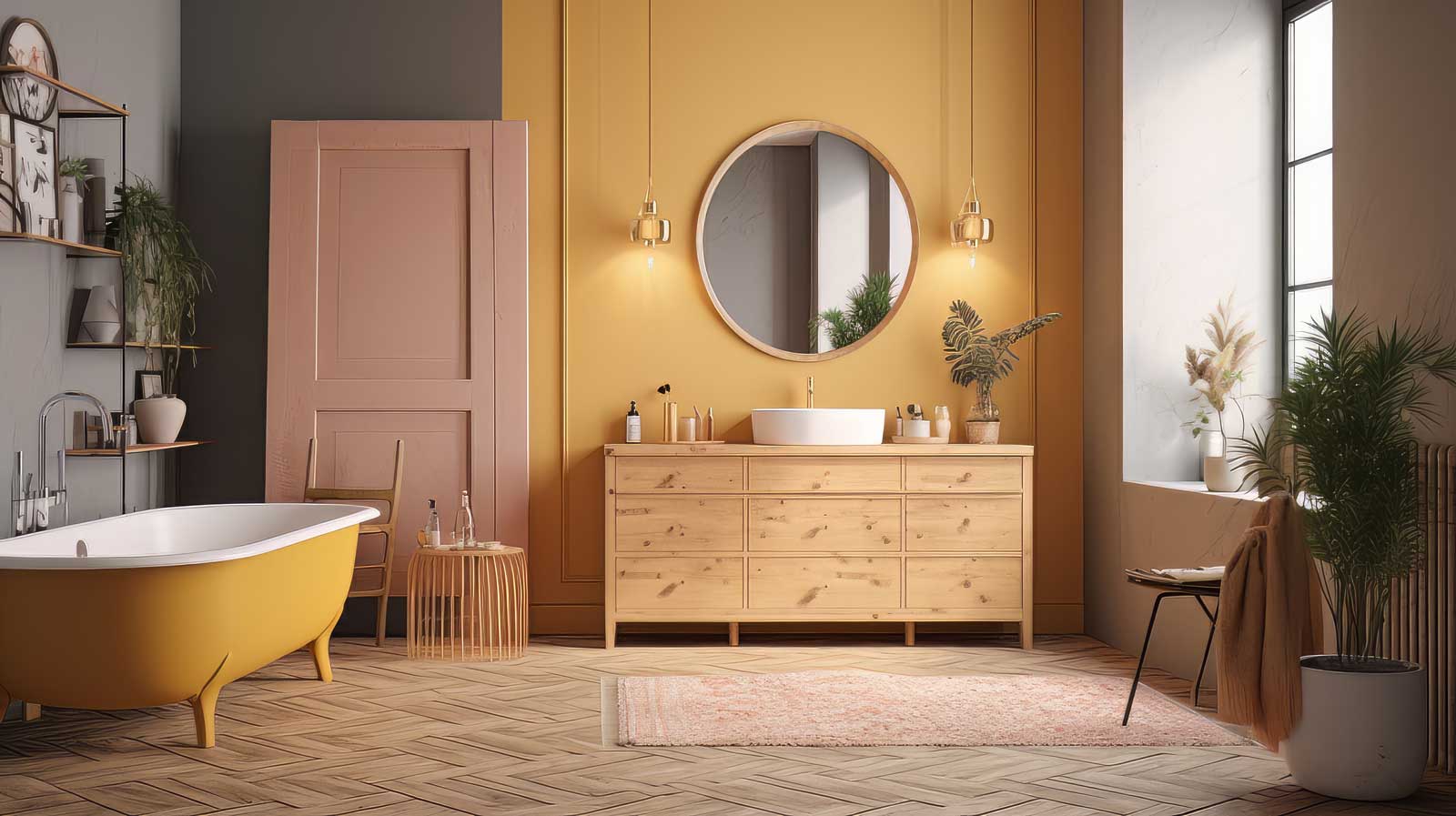
On the other hand, dark colors can evoke a more dramatic and cozy ambiance. Deep blues, charcoal grays, and rich emerald greens can add depth and intimacy to the bathroom. Dark-colored accent walls can be particularly striking when paired with well-placed lighting, as the interplay between light and shadow enhances the wall’s texture and color. This approach is ideal for creating a sense of luxury and indulgence, turning the bathroom into a sophisticated retreat.
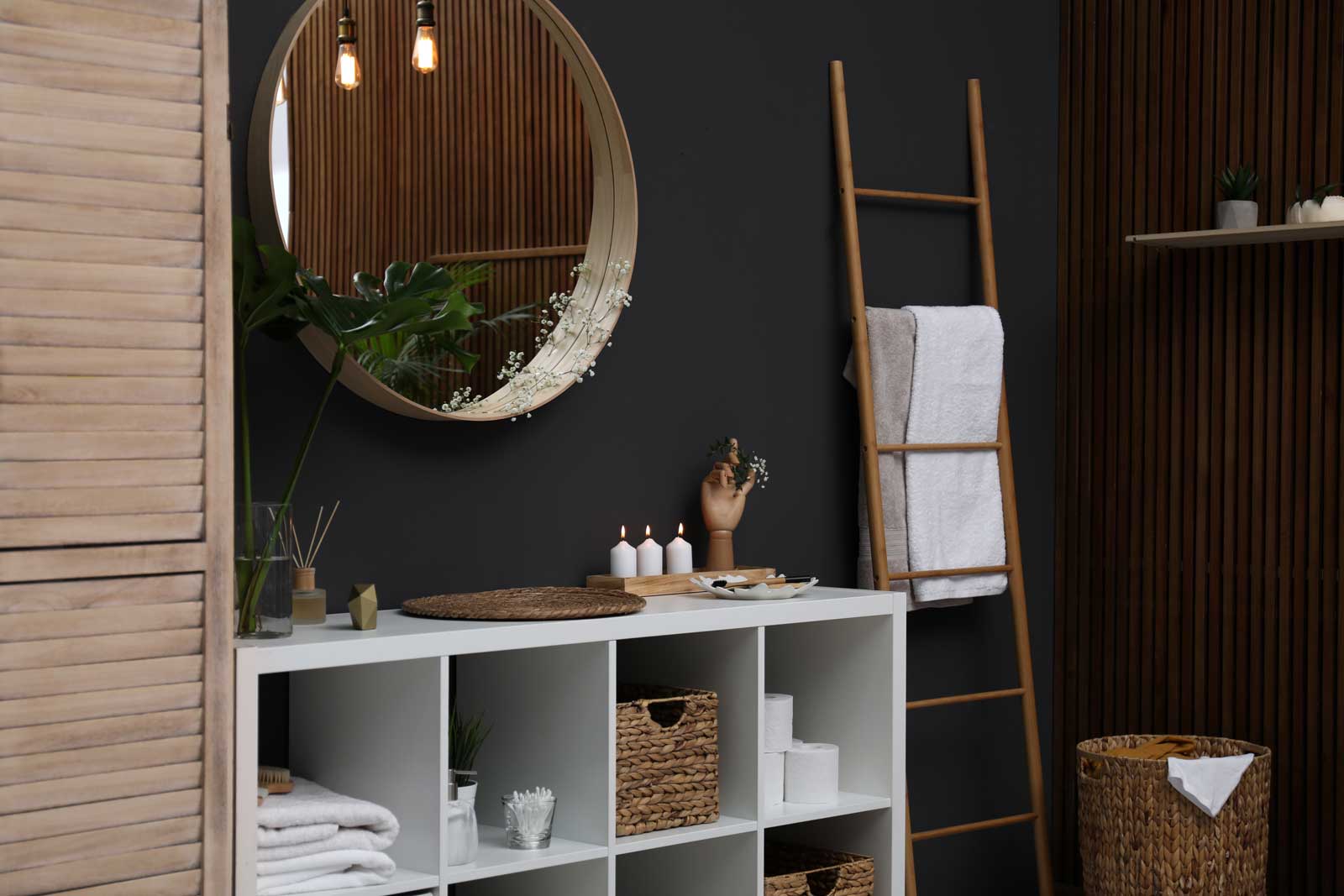
Trendy Bathroom Colors
Soft and earthy tones are currently in vogue when considering trendy colors for an accent wall in a bathroom. Shades like muted sage green, warm terracotta, and soft blush are gaining popularity for their ability to create a calming yet on-trend atmosphere. These colors add a touch of contemporary elegance while maintaining a soothing backdrop for the bathroom’s activities.
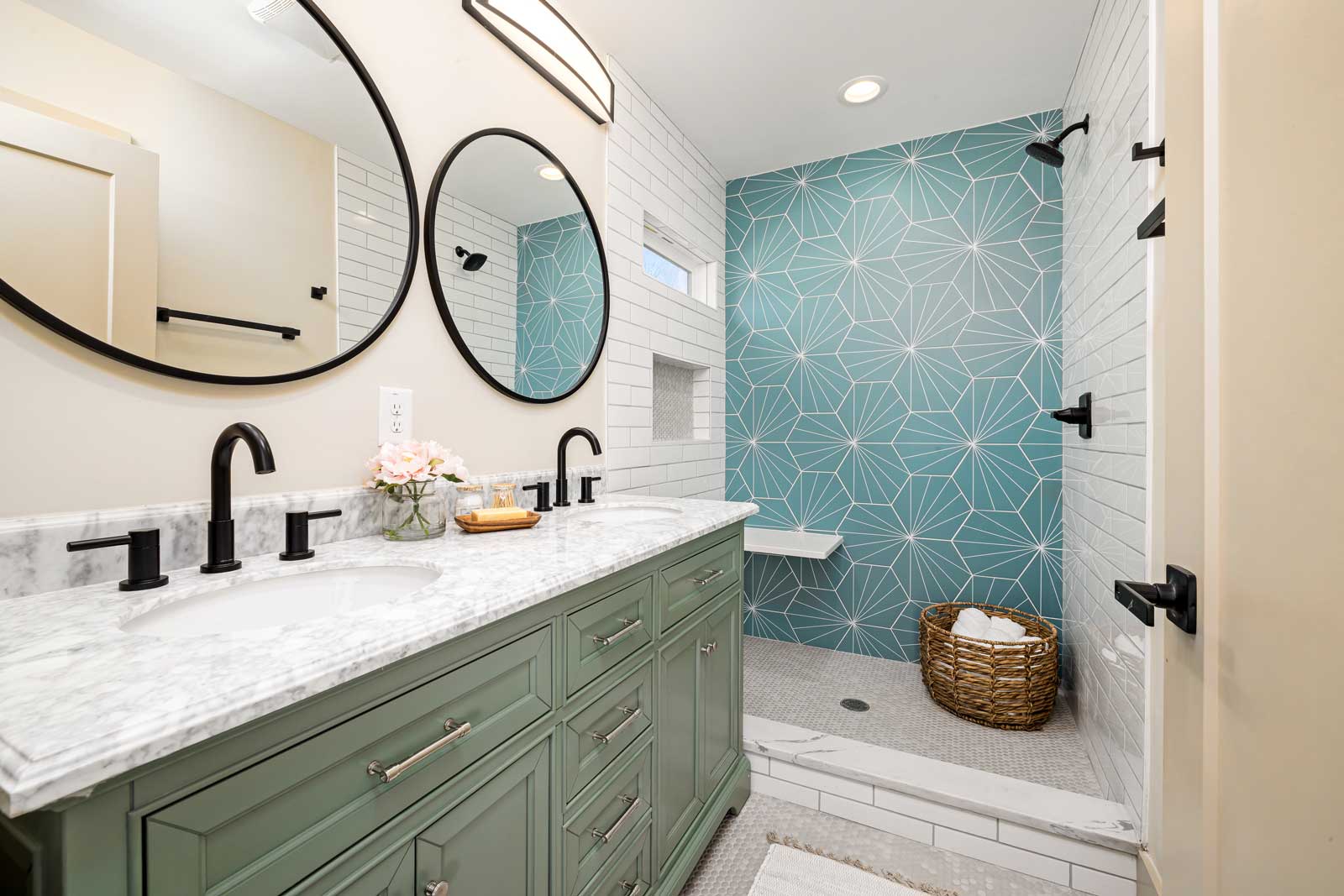
Paint Bases for Bathrooms
Regarding paint types, it’s crucial to choose a paint formulated explicitly for bathrooms due to the high moisture levels. It is important to use a primer labeled as “bathroom” or “moisture resistant” before you paint. These primers are designed to withstand the humidity and potential splashes that bathroom’s experience. They have mildew-resistant properties to prevent mold growth in damp conditions. Use satin or semi-gloss finish paint after the primer dries. These paint finishes offer durability and ease of cleaning, which is especially important in bathrooms. They can also repel moisture and resist stains, ensuring the accent wall maintains its vibrant appearance.
Tile Elegance: Ceramic, Porcelain, and Beyond
Utilizing tiles to craft a bathroom accent wall is a masterful way to introduce texture, pattern, and visual intrigue into the space. Tiles offer extensive design possibilities, from mosaic arrangements to intricate patterns and soothing gradients. The diverse materials available include ceramic, glass, porcelain, and natural stone.
What tile should I use for my accent wall?
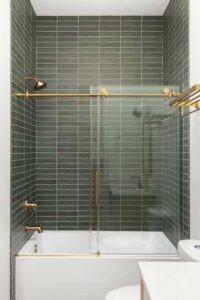
Ceramic Tiles: Ceramic tiles are made from clay fired at high temperatures. They come in various colors, patterns, and textures, making them highly versatile for design aesthetics. Ceramic tiles are known for their durability, water resistance, and ease of maintenance. They are commonly used for wall and floor applications and are a popular choice for bathrooms due to their affordability and versatility.
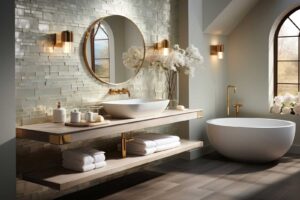
Glass Tiles: Glass tiles are made from thin pieces of glass that are often colored or translucent. They can create a stunning visual effect due to their reflective properties, making them ideal for capturing and reflecting light in the bathroom. Glass tiles are available in various sizes, shapes, and finishes, offering a modern and elegant look. They are often used as accent pieces or in mosaic patterns to add a touch of luxury and visual interest to a space.
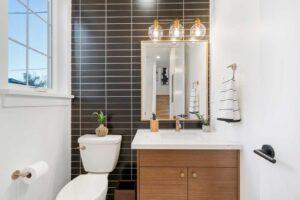
Porcelain Tiles: Porcelain tiles are a type of ceramic tile with added durability and water resistance. They are made from denser clay and fired at higher temperatures, making them highly suitable for areas with heavy foot traffic and exposure to moisture. Porcelain tiles can mimic the appearance of natural materials like stone or wood, offering a wide range of design possibilities. They are commonly used for both indoor and outdoor applications, including bathroom accent walls.
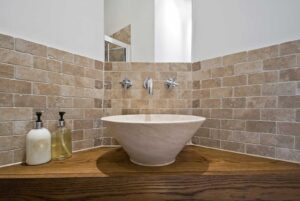
Natural Stone Tiles: Natural stone tiles are cut from quarried stone, such as marble, granite, travertine, slate, or limestone. Each type of stone has unique color variations and textures, resulting in a distinctive and organic appearance. Natural stone tiles lend a sense of luxury and timelessness to any space. However, they require more maintenance and sealing than other tile types due to their porous nature. They can be an excellent choice for creating a rustic, earthy, or sophisticated look on an accent wall.
Different ways to lay accent wall tiles.
When laying tiles for an accent wall, there are numerous patterns to choose from that can add visual interest, depth, and character to the space. Here are some popular tile patterns to consider:
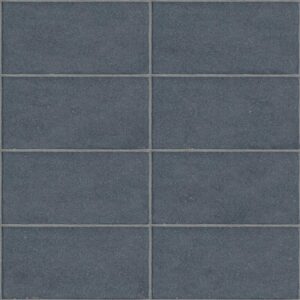
Straight Stack: This is one of the most straightforward patterns. Tiles are stacked directly on each other in a grid, creating clean lines and a modern aesthetic.
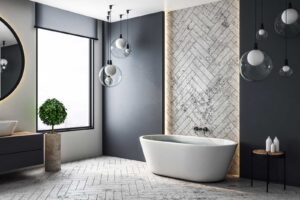
Herringbone: The herringbone pattern involves tiles arranged in a zigzag pattern, with each tile slanting at a 45-degree angle to create a “V” shape. This pattern adds movement and sophistication to the accent wall, making it a favorite for both traditional and contemporary designs.
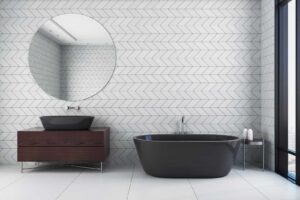
Chevron: Similar to the herringbone pattern, the chevron pattern features tiles laid in a V shape, but in this case, the tiles are cut at precise angles to create a seamless, continuous zigzag pattern. This pattern can be laid horizontally or vertically.
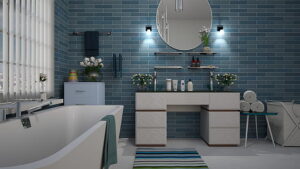 Subway: This layout replicates the way bricks are traditionally stacked. Each row is offset by half the width of the tile, creating a classic and timeless look that works well with rectangular tiles
Subway: This layout replicates the way bricks are traditionally stacked. Each row is offset by half the width of the tile, creating a classic and timeless look that works well with rectangular tiles
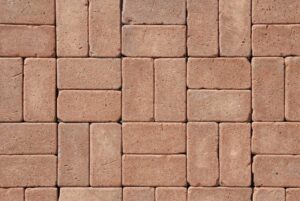 Basketweave: This intricate pattern involves rotating rectangular tiles to mimic the appearance of a woven basket. It adds a touch of elegance and texture to the accent wall, making it suitable for creating a focal point.
Basketweave: This intricate pattern involves rotating rectangular tiles to mimic the appearance of a woven basket. It adds a touch of elegance and texture to the accent wall, making it suitable for creating a focal point.
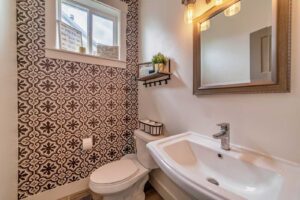
Mosaic: Mosaic patterns use small tiles to create intricate designs, images, or gradients. These patterns allow for endless creativity, and you can play with colors, textures, and shapes to craft a truly unique accent wall.
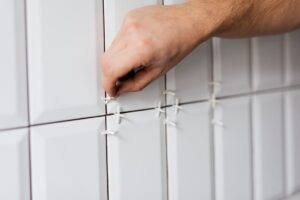 Vertical Stack: Instead of the typical horizontal layout, tiles are stacked vertically from floor to ceiling. This pattern can visually elongate the space and create a sense of height
Vertical Stack: Instead of the typical horizontal layout, tiles are stacked vertically from floor to ceiling. This pattern can visually elongate the space and create a sense of height
Choosing the right grout color
Choosing the right grout color for a tile accent wall is an important decision that can significantly impact the wall’s appearance. Here are some tips to help you select the perfect grout color:
Consider Tile Color and Material: Start by looking at the color and material of the tiles themselves. If you have tiles with a busy pattern or a lot of color variation, you might opt for a grout color that blends in rather than contrasts. If your tiles are a single, solid color, you can choose a grout color that complements or contrasts with the tile for a more dramatic effect.
Decide on Contrast: The level of contrast between the tile and grout can create different visual effects. A high-contrast grout color can emphasize the pattern and geometry of the tiles, making them stand out. On the other hand, low-contrast grout color can create a more cohesive and seamless appearance, allowing the focus to be on the overall texture and design of the wall.
Consider the Mood: Lighter grout colors can create a softer, more open feel, while darker grout colors can add drama and contrast. Neutral grout colors like gray or beige are versatile and work well with various tile colors and styles.
Think About Maintenance: Light-colored grout can quickly show dirt and stains, requiring more frequent cleaning. Darker grout colors can sometimes fade over time due to cleaning and wear. Consider your willingness to maintain the grout and choose a color that aligns with your maintenance preferences.
Wallpapers: From Vintage to Modern Charm
In recent years, there has been a remarkable resurgence of wallpaper as a favored choice for accent walls, particularly in bathrooms. This revival is fueled by a growing appreciation for design versatility and the desire to infuse personality into functional spaces. Wallpaper has transitioned from being seen as outdated to becoming a contemporary design tool that transforms bathrooms into unique havens of style and charm.
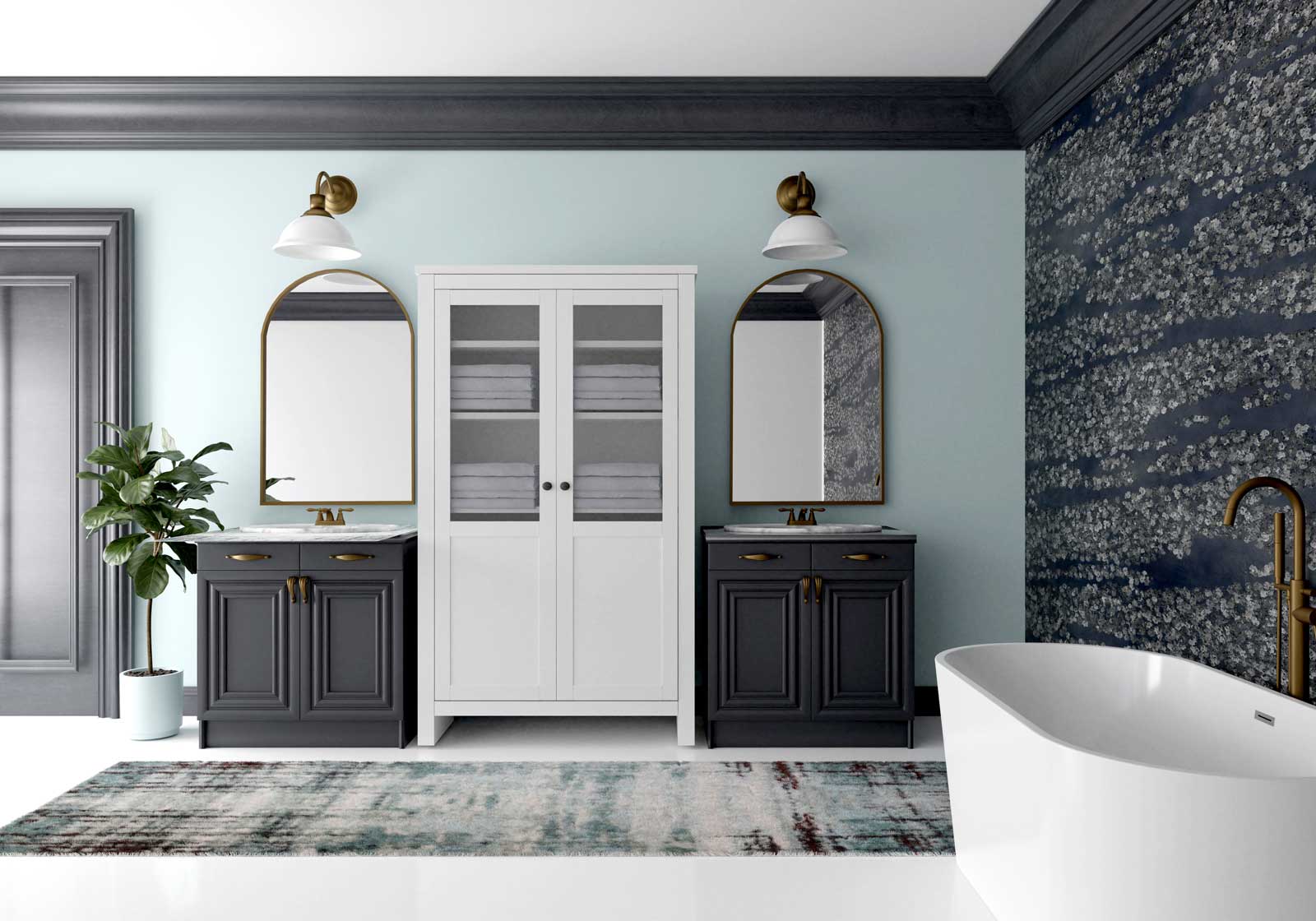
Using peel-and-stick wallpaper
One trend that has gained immense popularity is peel-and-stick vinyl wallpaper. This innovative product has revolutionized the wallpaper industry by offering a convenient and temporary solution. Peel-and-stick wallpaper doesn’t require traditional paste or professional installation; it adheres directly to the wall and can be easily removed without damaging the surface. This accessibility has opened up a world of possibilities for those who want to experiment with patterns, textures, and colors without a long-term commitment. Peel and stick vinyl wallpaper has mainly found a strong foothold in bathrooms, where its moisture-resistant properties ensure durability in the high-humidity environment.
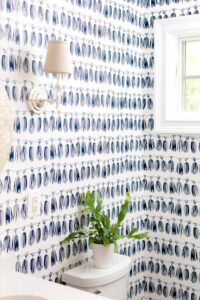
Pattern Versatility of accent wallpaper
Wallpaper now boasts a plethora of themes to suit every aesthetic inclination. From serene nature-inspired motifs to bold geometric patterns and elegant vintage designs, wallpaper provides an expansive canvas to tailor the bathroom’s ambiance to one’s personal taste. Natural landscapes can create a spa-like retreat, while abstract patterns add contemporary flair. Vintage wallpaper can infuse a sense of nostalgia, and metallic accents can evoke a touch of glamour. The versatility of wallpaper makes it a compelling choice for homeowners seeking to express their individuality and quickly transform a bathroom’s ambiance.
The resurgence of wallpaper as a preferred option for bathroom accent walls signifies a shift toward embracing diversity and creativity in interior design. The availability of peel-and-stick vinyl wallpaper has amplified this trend, allowing hassle-free experimentation with different styles. With its ability to cater to a wide range of themes and aesthetics, wallpaper has solidified its position as a design element that adds visual interest and conveys a unique narrative in bathroom spaces.
Have a professional help design and execute your bathroom renovation
More than an accent wall?
Get professional help to design and execute your bathroom renovation to ensure that every detail, including your accent wall, aligns seamlessly with your vision. While accent walls can be transformative, they’re just one facet of a comprehensive bathroom makeover. The Designery offers expertise in singular design elements, like choosing the perfect color or pattern for your accent wall and complete bathroom renovations. Our experienced designers can guide you through the entire process, from conceptualizing a cohesive theme to selecting materials, fixtures, and finishes that harmonize with your accent wall and overall design goals. Whether you want to enhance a specific focal point or embark on a holistic bathroom transformation, The Designery is your partner in bringing your dream space to life.
